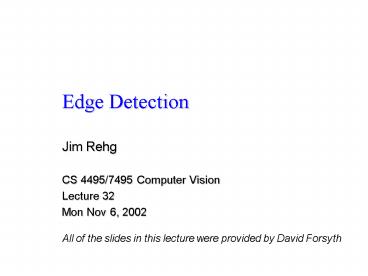Edge Detection PowerPoint PPT Presentation
1 / 28
Title: Edge Detection
1
Edge Detection
- Jim Rehg
- CS 4495/7495 Computer Vision
- Lecture 32
- Mon Nov 6, 2002
All of the slides in this lecture were provided
by David Forsyth
2
Gradients and edges
- Points of sharp change in an image are
interesting - change in reflectance
- change in object
- change in illumination
- noise
- Sometimes called edge points
- General strategy
- determine image gradient
- now mark points where gradient magnitude is
particularly large wrt neighbours (ideally,
curves of such points).
3
There are three major issues 1) The gradient
magnitude at different scales is different which
should we choose? 2) The gradient
magnitude is large along thick trail how
do we identify the significant points? 3) How
do we link the relevant points up into curves?
4
Smoothing and Differentiation
- Issue noise
- smooth before differentiation
- two convolutions to smooth, then differentiate?
- actually, no - we can use a derivative of
Gaussian filter - because differentiation is convolution, and
convolution is associative
5
1 pixel
3 pixels
7 pixels
The scale of the smoothing filter affects
derivative estimates, and also the semantics of
the edges recovered.
6
John Cannys Edge Detector
- John Canny, Finding Edges and Lines in Images,
Masters Thesis, MIT, June 1983. - Probably the most important Masters thesis in
computer vision! - Developed a practical edge detection algorithm
with three properties - Optimal kernel Justified use of Gaussian
- Non-maximum suppression remove edges orthogonal
to a maxima - Hysteresis thresholding Improved recovery of
long image contours
7
We wish to mark points along the curve where the
magnitude is biggest. We can do this by looking
for a maximum along a slice normal to the
curve (non-maximum suppression). These points
should form a curve. There are then two
algorithmic issues at which point is the
maximum, and where is the next one?
8
Non-maximum suppression
At q, we have a maximum if the value is larger
than those at both p and at r. Interpolate to get
these values.
9
Predicting the next edge point
Assume the marked point is an edge point. Then
we construct the tangent to the edge curve (which
is normal to the gradient at that point) and use
this to predict the next points (here either r or
s).
10
Remaining issues
- Check that maximum value of gradient value is
sufficiently large - drop-outs? use hysteresis
- use a high threshold to start edge curves and a
low threshold to continue them.
11
Notice
- Something nasty is happening at corners
- Scale affects contrast
- Edges arent bounding contours
12
(No Transcript)
13
fine scale high threshold
14
coarse scale, high threshold
15
coarse scale low threshold
16
Filters are templates
- Applying a filter at some point can be seen as
taking a dot-product between the image and some
vector - Filtering the image is a set of dot products
- Insight
- filters look like the effects they are intended
to find - filters find effects they look like
17
Normalized correlation
- Think of filters of a dot product
- now measure the angle
- i.e normalised correlation output is filter
output, divided by root sum of squares of values
over which filter lies
- Tricks
- ensure that filter has a zero response to a
constant region (helps reduce response to
irrelevant background) - subtract image average when computing the
normalizing constant (i.e. subtract the image
mean in the neighbourhood) - absolute value deals with contrast reversal
18
Positive responses
Zero mean image, -11 scale
Zero mean image, -maxmax scale
19
Positive responses
Zero mean image, -11 scale
Zero mean image, -maxmax scale
20
The Laplacian of Gaussian
- Another way to detect an extremal first
derivative is to look for a zero second
derivative - Appropriate 2D analogy is rotation invariant
- the Laplacian
- Bad idea to apply a Laplacian without smoothing
- smooth with Gaussian, apply Laplacian
- this is the same as filtering with a Laplacian of
Gaussian filter - Now mark the zero points where there is a
sufficiently large derivative, and enough contrast
21
sigma4
contrast1
LOG zero crossings
contrast4
sigma2
22
We still have unfortunate behaviour at corners
23
Orientation representations
- The gradient magnitude is affected by
illumination changes - but its direction isnt
- We can describe image patches by the swing of the
gradient orientation
- Important types
- constant window
- small gradient mags
- edge window
- few large gradient mags in one direction
- flow window
- many large gradient mags in one direction
- corner window
- large gradient mags that swing
24
Representing Windows
- Types
- constant
- small eigenvalues
- Edge
- one medium, one small
- Flow
- one large, one small
- corner
- two large eigenvalues
25
(No Transcript)
26
(No Transcript)
27
(No Transcript)
28
(No Transcript)

